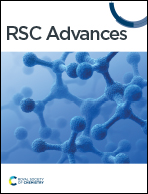Improved antioxidative and antibacterial activity of epigallocatechin gallate derivative complexed by zinc cations and chitosan
Abstract
Epigallocatechin gallate (EGCG) has attracted increasing attention thanks to its multi-bioactivities, and people are keen on improving the antioxidative and antibacterial performance of EGCG. Based on the favorable biofunctionality of Zn2+ and chitosan (CS), an EGCG derivative with a novel formula, i.e., EGCG–Zn–CS, is presented in this study. The structure of EGCG–Zn–CS was characterized by FT-IR, UV-vis, TGA, XPS, and SEM–EDS. The radical elimination results indicate that 0.1 mg mL−1 of EGCG–Zn–CS demonstrates DPPH radical and hydroxyl radical scavenging activities of 94.8% and 92.3%, while 0.1 mg mL−1 of EGCG exhibits only 78.5% and 75.6%, respectively, which means improved antioxidative activity of EGCG–Zn–CS was obtained. Inhibitory experiments against Staphylococcus aureus and Escherichia coli reveal that the minimal inhibitory concentrations (MICs) of EGCG–Zn–CS were 15.625 μg mL−1 and 187.5 μg mL−1, whereas the minimal bactericide concentrations (MBCs) were 46.875 μg mL−1 and 750 μg mL−1, respectively, which indicate that EGCG–Zn–CS exerts much higher antibacterial activity than EGCG. It can be concluded that the complexing of zinc cations and CS could amazingly improve both the antioxidative and antibacterial activity of EGCG, and it is expected that an exploration of EGCG–Zn–CS may inspire the development of simultaneous effective antioxidant and antibacterial agents.



 Please wait while we load your content...
Please wait while we load your content...